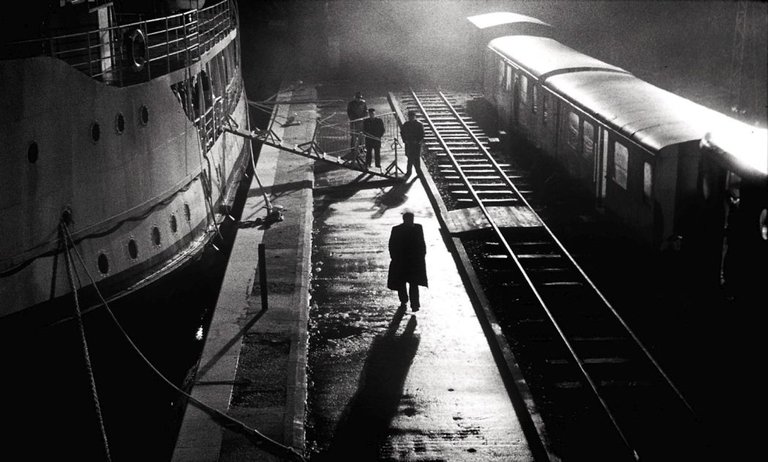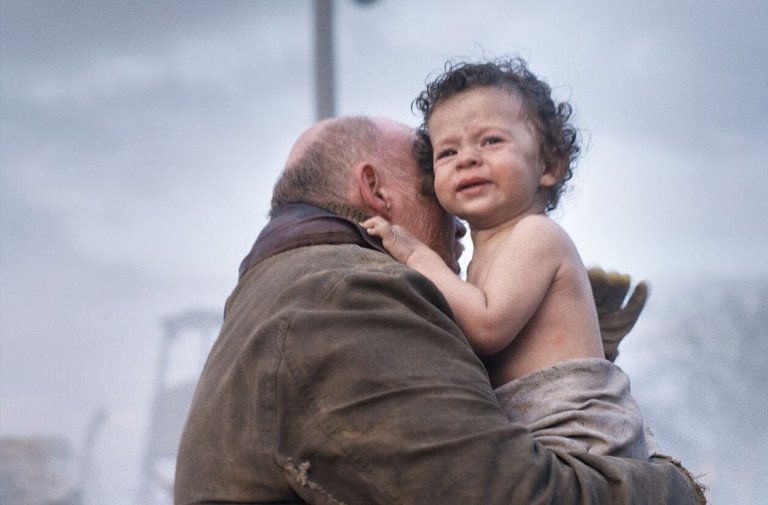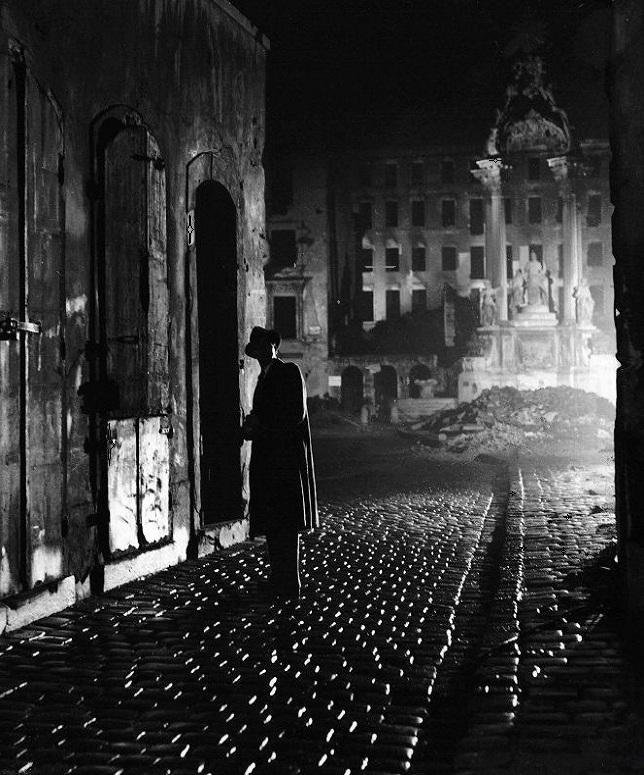The Third Man (1949): a film noir classic | un clásico del cine negro

Uno de los papeles más recordados de Orson Welles
The Third Man appears on lists of the best film noir films in history, best films of the 1940s, best British films, best thrillers and a ton of other lists. And of course it also stands out within the renowned filmography of Orson Welles, one of the Hollywood icons whom I recommend seeing not only as an actor but also as a director. It's obvious that I had it on my to-watch list for a long time, but a chance event made me finally see it.
The Third Man figura en las listas de las mejores películas de cine negro de la historia, mejores películas de los años cuarenta, mejores películas británicas, mejores thrillers y un montón de listas más. Y por supuesto también destaca dentro de la reconocida filmografía de Orson Welles, uno de los íconos de Hollywood a quien recomiendo ver no sólo como actor sino también como director. Es obvio que la tenía en mi lista de pendientes hacía tiempo, pero un hecho fortuito me hizo verla por fin.
Last week, going through some boxes of books in a library where I work, I came across a copy of Graham Greene's novel that bears the same name as the film, and while talking about the film (or rather the fact of not having seen it) my boss lent me the copy to read. It's a short story, less than 130 pages, that I was able to read in a couple of days, but it caught my attention that the book had a publication date of 1950, given that the film is from 1949, how is this possible? Well, in the introduction to the book, Graham Greene himself explains how director Carol Reed, after having worked together on the adaptation of another work by Greene himself, The Fallen Idol, asked him to write a script for a new movie. He proposed the setting and a couple of things, but the story had to be created by Greene. Confessing that he was not capable of writing a script from scratch, the British writer wrote the story to be based on it when adapting it into a film script. That is to say, basically the story is a draft of the story (although it's very well done and very complete) that was later adapted into a film script without the novel having seen the light because it had been written "to be seen and not to be read". After the success of the film, a year later The Third Man was edited and published as a novel and that's why its publication date is after the appearance of the film.
La semana pasada, revisando unas cajas de libros en una biblioteca en la que trabajo, me topé con un ejemplar de la novela de Graham Greene que lleva el mismo nombre de la película y al conversar sobre el film (o más bien sobre el hecho de no haberla visto) mi jefe me prestó el ejemplar para que lo leyese. Se trata de un relato corto, menos de 130 páginas, que pude leer en un par de días, pero me llamó la atención que el libro tuviera como fecha de publicación 1950, siendo que la película es de 1949, ¿cómo es posible? Bien, en la introducción del libro, el propio Graham Greene explica la forma en que el director Carol Reed, después de haber trabajado juntos en la adaptación de otra obra del mismo Greene, The Fallen Idol, le pidió a este que escribiera un guión para una nueva película. Le propuso el escenario y un par de cosas, pero la historia tenía que ser creada por el propio Greene. Confesando que no era capaz de escribir un guión desde cero, el escritor británico escribió el relato para basarse en él a la hora de adaptarlo a guión de cine. Es decir, básicamente el relato es un borrador de la historia (aunque está muy bien logrado y muy completo) que luego adaptó a guión cinematográfico sin que la novela hubiera visto la luz porque había sido escrita "para ser vista y no para ser leída". Tras el éxito de la película, un año más tarde The Third Man fue editada y publicada como novela y es por eso que su fecha de publicación es posterior a la aparición de la película.

One of the director's conditions was that the story took place in post-war Vienna. The year was 1949, the Second World War was still very fresh in the memory and in the lives of the people who had to live and survive in a Europe that was beginning to rebuild itself. Liberated simultaneously by the Allies and Russia, after the war the Austrian capital became a nightmare of jurisdictions.
Una de las condiciones del director era que la historia se desarrollara en la Viena de la post guerra. Corría el año de 1949, la segunda guerra mundial aún estaba muy fresca en la memoria y en la vida de las personas que debían vivir y sobrevivir en una Europa que comenzaba a reconstruirse. Liberada en simultáneo por los aliados y por Rusia, después de la guerra la caítal austríaca se convirtió en una pesadilla de jurisdicciones.
Imagine a city divided into four sectors, each of them under the control of one of the four winning forces in the war: France, the United States, England and Russia. Communication was difficult, especially with the Russians, and any police investigation involving two or more of the police forces was a bureaucratic labyrinth for which there was almost never time. Asking for authorization for a raid, tracking down a criminal who was taking refuge in an area outside the jurisdiction of his pursuers, and other similar things, added to a city still partially in ruins, a recovering economy that also had to survive the speculation and what accompanies all crises: the black market. All this gives us the framework of the story, the environment within which the death of Harry Lime occurs, a fact that generates different reactions in the different characters of the novel. The police investigate little and close the case quickly because Lime was a disturbing element in the city since he trafficked goods on the black market; His friend Holly Martins, who arrived from the US, finds some of the circumstances surrounding his friend's death very suspicious and decides to investigate on his own, asking questions here and there, not always to the most recommendable people. And Anna, Lime's former girlfriend, is torn between missing him, being grateful that he died and did not have to face a very long court sentence, wishing she had never met him, exonerating him or recognizing that he deserved what happened to him.
Imaginen una ciudad dividida en cuatro sectores, cada una de ellas bajo el control de una de las cuatro fuerzas vencedoras en la guerra: Francia, EEUU, Inglaterra y Rusia. La comunicación era difícil, sobre todo con los rusos, y cualquier investigación policíaca en la que se vieran involucrados dos o más de los cuerpos policiales era un laberinto burocrático para el cual casi nunca había tiempo. Pedir autorización para un allanamiento, seguirle la pista a un criminal que se refugiaba en una zona fuera de la jurisdicción de sus perseguidores, y otras cosas similares, sumado a una ciudad aún parcialmente en ruinas, una economía en recuperación que debía también sobrevivir a la especulación y a lo que acompaña todas las crisis: el mercado negro. Todo esto nos da el marco de la historia, el ambiente dentro del cual se presenta la muerte de Harry Lime, un hecho que genera diversas reacciones en los diferente personajes de la novela. La policía investiga poco y cierra el caso rápido porque Lime era un elemento perturbador en la ciudad ya que traficaba con bienes en el mercado negro; su amigo Holly Martins, llegado desde los EEUU, encuentra muy sospechosas algunas circunstancias que rodean la muerte de su amigo y decide investigar por cuenta propia haciendo preguntas aquí y allá, no siempre a la gente más recomendable. Y Anna, antigua novia de Lime, se debate entre extrañarlo, agradecer que haya muerto y no haya tenido que enfrentar una larguísima condena judicial, desear no haberlo conocido, exculparlo o reconocer que merecía lo que le pasó.

All this makes the story develop in an ambiguous but interesting way, since the viewer doesn't know who to believe or how to feel about the death of a character whom he only knows by hearsay. The mystery grows and is maintained until the climax of the story when the truth turns out to be more implausible than any theory inferred until then and at the end there's a chase sequence that's one of the best I've seen in the cinema of those years. The Third Man is a detective story with a contradictory central character, witty lines in the script, great direction and very good photography, shots with the tilted camera, close-ups, plays of light and shadows, a appropriate music that many consider hypnotic and a story very well adapted by the same author of the original story who changed some things, ideas, lines of some characters, the name and nationality of the protagonist (the American Holly in the film was an English called Rollo in the book), just to make it even more cinematographic. Compared to the thrillers of today and the expectations of today's audiences, The Third Man may lack violence, that is, those bloody or disturbing scenes that we see in David Fincher's films, but it makes up for a good script, good photography and a more interesting story than most of the productions of the genre available on the different streaming platforms today.
Todo esto hace que la historia se desarrolle de manera ambigua, pero interesante, pues el espectador no sabe a quién creer ni cómo sentirse respecto a la muerte de un personaje al que sólo conoce de oídas. El misterio crece y se matiene hasta el clímax de la historia cuando la verdad resulta más inverosímil que cualquier teoría hasta entonces inferida y al final hay una secuencia de una persecución que es de lo mejor que he visto en el cine de esos años. The Third Man es una historia policíaca con un personaje central contradictorio, líneas ingeniosas en el guión, una gran dirección y una muy buena fotografía, tomas con la cámara inclinada, primeros planos, juegos de luces y sombras, una música apropiada que muchos consideran hipnótica y una historia muy bien adaptada por el mismo autor del relato original al cual le cambió algunas cosas, ideas, líneas de algunos personajes, el nombre y la nacionalidad del protagonista, (el norteamericano Holly en la película era un inglés llamado Rollo en el libro), sólo para hacerla aún más cinematográfica. Comparada a los thrillers de los tiempos de ahora y a las expectativas del público de hoy, a The Third Man quizás le falte violencia, es decir esas escenas sangrientas o perturbadoras que vemos en las películas de David Fincher, pero lo compensa un buen guión, buena fotografía y una historia más interesante que la mayoría de las producciones del género disponibles en las diferentes plataformas de streaming de la actualidad.

In this case the final recommendation is threefold. I invite you to review Carol Reed's other works as a director, among which Odd Man Out, The Agony and the Ecstasy and Our Man in Havana stand out, this one also adapted by Graham Greene from his own novel. The second invitation is to read Greene, of whom The quiet American, The Honorary Consul, The Human Factor or the well-known The Power and the Glory stand out a lot. And finally, for those who do not yet know him or have seen very little of him, I recommend looking for more of Orson Welles' filmography. As an actor he stood out in many films directed by himself, but one that I remember he did not direct was Jane Eyre, an adaptation of the novel by Charlotte Brönte. But the best of Welles was perhaps when he directed himself, landing incredible roles and films such as The Lady from Shanghai, The Stranger, Macbeth and Othello (both adaptations of Shakespeare's works) and of course the one that is considered by many to be the best film in the history of cinema: Citizen Kane. You definitely have to check out the name of Orson Welles if you consider yourself a film buff at heart and for that I think The Third Man is a good way to introduce yourself to him. Have any of you heard of this film? have you seen it? I read you in the comments.
En este caso la recomendación final es triple. Les invito a revisar otros trabajos de Carol Reed como director entre los que destacan Odd Man Out, The Agony and the Ecstasy y Our Man in Havana, esta también adaptada por Graham Greene a partir de una novela propia. La segunda invitación es a leer a Greene, de quien destacan mucho The quiet american, The Honorary Consul, The Human Factor o la muy conocida The Power and the Glory. Y finalmente para quienes aún no lo conozcan o lo hayan visto muy poco les recomiendo buscar más de la filmografía de Orson Welles. Como actor destacó en muchas películas dirigidas por él mismo, pero una que recuerdo que él no dirigió fue Jane Eyre, adaptación de la novela de Charlotte Brönte. Pero lo mejor de Welles quizás fue cuando se dirigió a sí mismo, consiguiendo papeles y películas increíbles como The Lady from Shangai, The Stranger, Macbeth y Othello (ambas adaptaciones de obras de Shakespeare) y por supuesto la que está considerada por muchos como la mejor película de la historia del cine: Citizen Kane. Definitivamente hay que revisar el nombre de Orson Welles si uno se considera un cinéfilo de corazón y para ello creo que The Third Man es una buena forma de introducirse a él ¿alguno de ustedes había oído de esta película? ¿la han visto? Los leo en los comentarios.
Reviewed by | Reseñado por @cristiancaicedo
Other posts that may interest you | Otros posts que pueden interesarte:
  |
|---|



